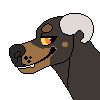Physical traits guide!
Height range:
12hh - 16hh, with cows tending to be larger and bulls tending to be smaller
Lifespan:
15-20 years in the wild, 30+ in captivity
Noteable Traits
- Broad, triangular necks
- Straight backs
- Short, bristled mane with a longer patch at the withers
- Short upper canines, used for foraging and threat displays
- Long, fluffy tails; used for balance, and to keep warm
- Prehensile tongues
- Large, tufted ears
Dimorphism
Cows have:
- Longer horns
- Sleek legs
- Are on average, larger
Bulls have:
- Shorter horns
- Fluffy pasterns on their front legs, used in a pracing courtship display
- Are on average, smaller
-----
Behaviour
Brush-tailed antelope are herd animals, with groups generally being led by an elder cow, or a pair.
Bucks are often nomadic, but settling with a herd is not unheard of.
Cow antelope use their larger size and horns to defend their young and elderly, while bucks are more flighty and rely on show to impress potential mates.
Young antelope take about 3 years to mature, at which point they will often disperse (although not always)
Diet
Brush-tailed antelope are Primarily herbivores, but will eat insects for protein during lean times
Primarily scrub grass and roots - their tusks are excellent for digging, stripping tree bark, and boring for grubs and insects
Honey and tree sap are favoured treats
In Captivity
Brush-tailed antelope are fickle to keep in captivity due to their eating habits, but when kept in groups, there has been some success.
They do best with their own species, but can be bonded to any herd, and cow antelope are sometimes used in leiu of donkeys or llamas to protect sheep or cows due to their protective nature.
They can also be used to pull carts and wagons, for non-mounted sports, or as pack animals.
Brush Tailed Antelope - Physical Traits + Behaviour by flyteck
| Based on | Click to view |
| Artist | flyteck [gallery] |
| Time spent | 8 minutes |
| Drawing sessions | 1 |
| 5 people like this | Log in to vote for this drawing |
1 post
• Page 1 of 1
Brush Tailed Antelope - Physical Traits + Behaviour
⤁⤁⤁⤁⤁⤁⤁⤁⤁⤁⤁⤁⤁⤁⤁⤁⤁⤁⤁⤁⤁⤁⤁⤁⤁⤁⤁⤁⤁⤁⤁⤁⤁⤁⤁⤁⤁⤁⤁⤁⤁⤁⤁⤁⤁⤁
❦ Also on DA & Comicfury
❦ My WMEs
I'm still on here, but I don't post much.
Feel free to message me if you'd like to chat!
⤁⤁⤁⤁⤁⤁⤁⤁⤁⤁⤁⤁⤁⤁⤁⤁⤁⤁⤁⤁⤁⤁⤁⤁⤁⤁⤁⤁⤁⤁⤁⤁⤁⤁⤁⤁⤁⤁⤁⤁⤁⤁⤁⤁⤁⤁
-

flyteck - Posts: 15333
- Joined: Mon Jul 18, 2011 7:32 am
- My pets
- My items
- My wishlist
- My gallery
- My scenes
- My dressups
- Trade with me
1 post
• Page 1 of 1
Who is online
Users browsing this forum: SonrienteMuerte, werepickle, Zentropy and 48 guests


